The 3D reverse engineering software market stands at the threshold of a decade-long expansion trajectory that promises to reshape digital manufacturing applications and advanced software development across aerospace contractors, automotive manufacturers, and heavy equipment operations. The market's journey from USD 338.7 million in 2025 to USD 573.2 million by 2035 represents substantial growth, demonstrating the accelerating adoption of specialized reverse engineering solutions and premium software technologies across manufacturing facilities, design centers, and engineering consultancies.
The first half of the decade (2025 to 2030) will witness the market climbing from USD 338.7 million to approximately USD 428.1 million, adding USD 89.4 million in value, which constitutes 38% of the total forecast growth period. This phase will be characterized by the rapid adoption of advanced software technologies, driven by increasing manufacturing digitization and the growing need for high-performance reverse engineering solutions in complex product development environments worldwide. Enhanced cloud-based features and precision modeling capabilities will become standard expectations rather than premium options.
The latter half (2030 to 2035) will witness accelerated growth from USD 428.1 million to USD 573.2 million, representing an addition of USD 145.1 million or 62% of the decade's expansion. This period will be defined by mass market penetration of premium reverse engineering technologies, integration with comprehensive digital manufacturing platforms, and seamless compatibility with existing CAD/CAM infrastructure. The market trajectory signals fundamental shifts in how manufacturers approach product development and legacy system digitization, with participants positioned to benefit from growing demand across multiple software types and application segments.
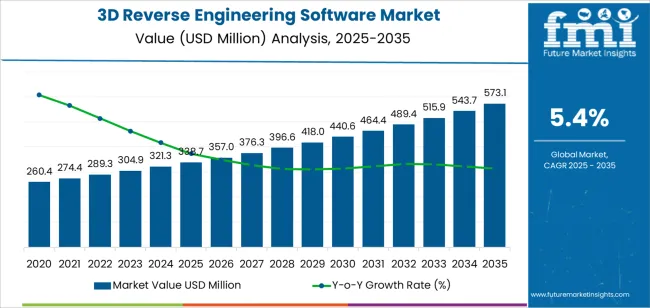
| Period | Primary Revenue Buckets | Share | Notes |
|---|---|---|---|
| Today | Cloud-based Solutions (aerospace, automotive) | 58% | Scalable applications, established industries |
| On-premise Software (heavy equipment, manufacturing) | 42% | Legacy systems, specialized applications | |
| Future (3-5 yrs) | Advanced Cloud Platforms | 62-65% | Enhanced processing power, AI integration |
| Aerospace Applications | 18-22% | Aircraft development, space programs | |
| Automotive Solutions | 15-18% | Electric vehicles, autonomous systems | |
| Heavy Equipment Engineering | 12-15% | Construction machinery, industrial equipment | |
| Consumer Goods Design | 8-12% | Product development, customization | |
| Manufacturing Integration | 6-10% | Production line optimization, quality control |
At-a-Glance Metrics
| Metric | Value |
|---|---|
| Market Value (2025) | USD 338.7 million |
| Market Forecast (2035) | USD 573.2 million |
| Growth Rate | 5.4% CAGR |
| Leading Product | Cloud-based Solutions |
| Primary Application | Aerospace & Automotive |
The market demonstrates strong fundamentals with cloud-based software systems capturing a dominant share through advanced processing capabilities and industrial application optimization. Aerospace and automotive applications drive primary demand, supported by increasing digitization requirements and manufacturing equipment modernization initiatives. Geographic expansion remains concentrated in developed markets with established manufacturing infrastructure, while emerging economies show accelerating adoption rates driven by industrial transformation initiatives and rising precision engineering standards.
Design for comprehensive workflow integration, not just standalone applications
Manufacturing integration readiness
Quality-by-design approach
Value-based pricing models
Primary Classification: The market segments by deployment type into cloud-based solutions and on-premise software, representing the evolution from traditional desktop applications to sophisticated cloud-enabled platforms for comprehensive reverse engineering optimization.
Secondary Classification: Application segmentation divides the market into aerospace, automotive and transportation, consumer goods, heavy equipment, manufacturing, and others, reflecting distinct requirements for processing capabilities, accuracy standards, and integration specifications.
Tertiary Classification: End-use segmentation covers aerospace manufacturers, automotive companies, heavy equipment producers, consumer goods manufacturers, and engineering consultancies, while distribution channels span direct sales, software distributors, and specialized technology providers.
Regional Classification: Geographic distribution covers North America, Latin America, Western Europe, Eastern Europe, East Asia, South Asia Pacific, and Middle East & Africa, with developed markets leading adoption while emerging economies show accelerating growth patterns driven by manufacturing modernization programs.
The segmentation structure reveals deployment progression from traditional on-premise software toward sophisticated cloud-based platforms with enhanced processing capabilities, while application diversity spans from aerospace development to consumer goods manufacturing requiring precision reverse engineering solutions.
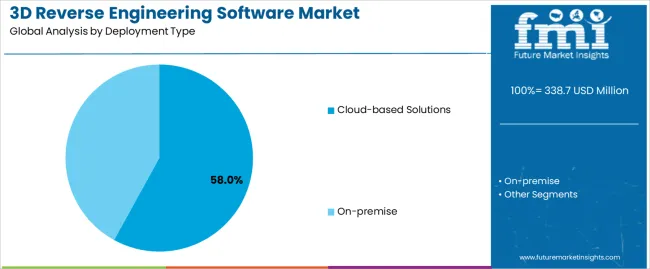
Market Position: Cloud-based reverse engineering systems command the leading position in the 3D reverse engineering software market with 58% market share through proven software technologies, including scalable processing construction, collaborative capabilities, and precision modeling optimization that enable engineering teams to achieve optimal project outcomes across diverse aerospace and automotive environments.
Value Drivers: The segment benefits from industrial preference for scalable software systems that provide reliable performance, accessibility, and operational flexibility without requiring specialized hardware infrastructure. Advanced cloud processing features enable enhanced computational power, collaborative workflows, and integration with existing engineering programs, where processing reliability and data accessibility represent critical operational requirements.
Competitive Advantages: Cloud-based reverse engineering systems differentiate through proven scalability, collaborative characteristics, and integration with established engineering workflows that enhance team effectiveness while maintaining optimal processing standards suitable for diverse industrial applications.
Key market characteristics:
On-premise reverse engineering systems maintain a 42% market position in the 3D reverse engineering software market due to their security advantages and specialized application benefits. These products appeal to facilities requiring complete data control with enhanced security profiles for high-precision operations. Market growth is driven by heavy equipment expansion, emphasizing specialized reverse engineering solutions and operational reliability through optimized software designs.
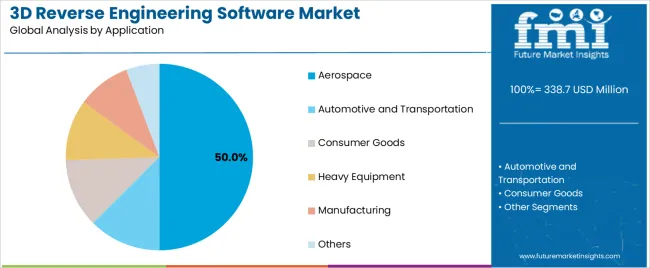
Market Context:Aerospace applications demonstrate strong growth in the 3D reverse engineering software market, holding a 50% share. This growth is driven by the widespread adoption of advanced reverse engineering systems and a growing focus on operational excellence, precision efficiency, and development applications that enhance engineering effectiveness while maintaining aerospace standards.
Appeal Factors: Aerospace operators prioritize software reliability, processing consistency, and integration with existing aerospace infrastructure that enables coordinated engineering operations across multiple aircraft systems. The segment benefits from substantial aerospace industry investment and modernization programs that emphasize the acquisition of premium software for development differentiation and operational efficiency applications.
Growth Drivers: Aerospace expansion programs incorporate reverse engineering software as essential components for aircraft development, while defense aerospace growth increases demand for engineering capabilities that comply with military standards and minimize operational complexity.
Market Challenges: Varying certification requirements and operational complexity may limit software standardization across different aircraft or system scenarios.
Application dynamics include:
Automotive applications capture 28% market share through specialized development requirements in vehicle manufacturing, electric vehicle development, and automotive engineering applications. These facilities demand premium software capable of supporting complex automotive systems while providing precision access and operational reliability capabilities.
Consumer Goods Applications Show Technology Growth
Consumer goods applications account for 22% market share, including product development facilities, design studios, and manufacturing requiring performance reverse engineering capabilities for innovation optimization and operational effectiveness.
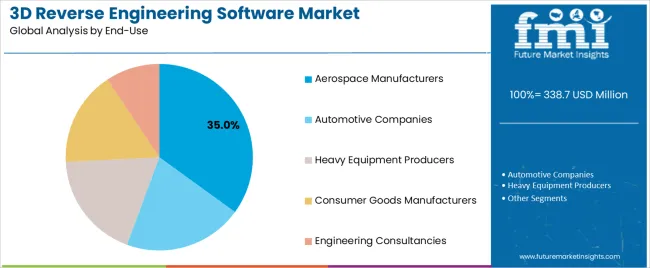
Market Context:Aerospace manufacturers dominate the market, holding a 35% share, as they represent the primary demand source for reverse engineering technology in industrial applications and operational standardization.
Business Model Advantages: Aerospace Manufacturers provide direct market demand for specialized reverse engineering systems, driving precision software development and performance optimization while maintaining quality control and safety requirements.
Operational Benefits: Aerospace Manufacturer applications include safety standardization, operational efficiency, and performance assurance that drive consistent demand for reverse engineering systems while providing access to latest software technologies.
| Category | Factor | Impact | Why It Matters |
|---|---|---|---|
| Driver | Manufacturing digitization & Industry 4.0 adoption (aerospace modernization, automotive development) | ★★★★★ | Growing manufacturing market requires advanced software with enhanced processing capabilities and precision modeling properties proven effective across industrial applications. |
| Driver | Processing power advancement & accuracy requirements (complex geometries, high-resolution scanning) | ★★★★★ | Transforms engineering requirements from "basic CAD tools" to "advanced reverse engineering platforms"; operators that offer quality software and precision features gain competitive advantage. |
| Driver | Automotive electrification & precision manufacturing (EV development, autonomous systems) | ★★★★☆ | Automotive facilities need specialized, high-performance reverse engineering; demand for precision and superior modeling solutions expanding addressable market. |
| Restraint | High software costs & budget constraints (especially for small manufacturers) | ★★★★☆ | Smaller engineering firms defer software upgrades; increases price sensitivity and slows premium software adoption in cost-conscious markets. |
| Restraint | Alternative CAD software competition (traditional modeling, basic reverse engineering) | ★★★☆☆ | Standard CAD alternatives offer established workflows and lower costs, potentially limiting specialized reverse engineering adoption in traditional applications. |
| Trend | AI integration & machine learning enhancement (automated processing, intelligent recognition) | ★★★★★ | Advanced AI capabilities, processing optimization, and automated analytics transform operations; technology integration and performance enhancement become core value propositions. |
| Trend | Cloud collaboration & remote engineering (distributed teams, real-time collaboration) | ★★★★☆ | Cloud-based collaboration for distributed teams and projects; collaborative features and remote capabilities drive competition toward integrated solutions. |
The 3D reverse engineering software market demonstrates varied regional dynamics with Growth Leaders including China (7.3% growth rate) and India (6.8% growth rate) driving expansion through manufacturing development initiatives and engineering modernization. Steady Performers encompass Germany (6.2% growth rate), Brazil (5.7% growth rate), and developed regions, benefiting from established manufacturing infrastructure and advanced software adoption. Mature Markets feature United States (5.1% growth rate), United Kingdom (4.6% growth rate), and Japan (4.1% growth rate), where manufacturing advancement and precision engineering requirements support consistent growth patterns.
Regional synthesis reveals East Asian markets leading adoption through manufacturing expansion and engineering development, while North American countries maintain steady expansion supported by software technology advancement and performance standardization requirements. European markets show strong growth driven by industrial applications and digitization integration trends.
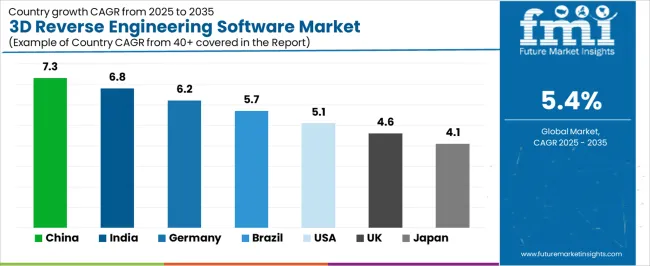
| Region/Country | 2025 to 2035 Growth | How to win | What to watch out |
|---|---|---|---|
| China | 7.3% | Focus on manufacturing solutions | Regulatory changes; local competition |
| India | 6.8% | Lead with cost-effective platforms | Import restrictions; infrastructure barriers |
| Germany | 6.2% | Provide premium quality software | Over-regulation; lengthy approvals |
| Brazil | 5.7% | Offer value-oriented solutions | Currency fluctuations; import duties |
| United States | 5.1% | Push technology integration | Compliance costs; scaling challenges |
| United Kingdom | 4.6% | Focus on precision applications | Economic impacts; software costs |
| Japan | 4.1% | Emphasize quality engineering | Traditional preferences; adoption rates |
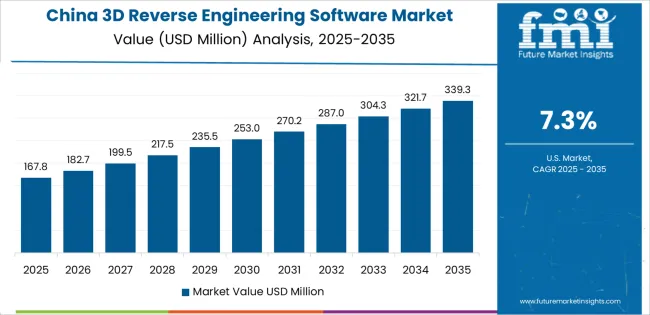
China establishes fastest market growth through aggressive manufacturing development programs and comprehensive engineering expansion, integrating advanced 3D reverse engineering software systems as standard components in aerospace facilities and automotive manufacturing installations. The country's 7.3% growth rate reflects government initiatives promoting industrial infrastructure and domestic software capabilities that mandate the use of advanced reverse engineering systems in aerospace and automotive manufacturing facilities. Growth concentrates in major industrial hubs, including Beijing, Shanghai, and Shenzhen, where manufacturing development showcases integrated software systems that appeal to industrial operators seeking performance optimization capabilities and operational applications.
Chinese manufacturers are developing cost-effective reverse engineering solutions that combine domestic production advantages with advanced software features, including enhanced processing control and improved accuracy capabilities. Distribution channels through software suppliers and engineering distributors expand market access, while government support for manufacturing development supports adoption across diverse aerospace and automotive segments.
Strategic Market Indicators:
In Mumbai, Delhi, and Bangalore, manufacturing facilities and automotive operators are implementing advanced 3D reverse engineering software systems as standard equipment for operational optimization and development applications, driven by increasing government industrial investment and manufacturing modernization programs that emphasize the importance of precision engineering capabilities.
The market holds a 6.8% growth rate, supported by government industrial initiatives and manufacturing development programs that promote advanced reverse engineering systems for aerospace and automotive facilities. Indian operators are adopting software systems that provide consistent processing reliability and accuracy features, particularly appealing in industrial regions where development performance and operational excellence represent critical business requirements.
Market expansion benefits from growing manufacturing capabilities and international engineering partnerships that enable domestic development of advanced reverse engineering systems for aerospace and automotive applications. Technology adoption follows patterns established in manufacturing equipment, where reliability and performance drive procurement decisions and operational deployment.
Market Intelligence Brief:
Advanced industrial market in Germany demonstrates sophisticated 3D reverse engineering deployment with documented performance effectiveness in aerospace applications and automotive manufacturing facilities through integration with existing industrial systems and operational infrastructure. The country leverages engineering expertise in software and quality systems integration to maintain a 6.2% growth rate. Industrial centers, including Bavaria, Baden-Württemberg, and North Rhine-Westphalia, showcase premium installations where reverse engineering systems integrate with comprehensive manufacturing platforms and facility management systems to optimize development performance and operational effectiveness.
German manufacturers prioritize system quality and EU compliance in software development, creating demand for premium systems with advanced features, including facility integration and performance monitoring systems. The market benefits from established manufacturing infrastructure and a willingness to invest in advanced reverse engineering technologies that provide long-term operational benefits and compliance with international manufacturing standards.
Market Intelligence Brief:
3D reverse engineering software marketexpansion in Brazil benefits from diverse manufacturing demand, including automotive modernization in São Paulo and Rio de Janeiro, aerospace facility upgrades, and government industrial programs that increasingly incorporate advanced reverse engineering solutions for development applications. The country maintains a 5.7% growth rate, driven by rising manufacturing activity and increasing recognition of advanced software benefits, including precise development control and enhanced operational effectiveness.
Market dynamics focus on cost-effective reverse engineering solutions that balance processing reliability with affordability considerations important to Brazilian manufacturing operators. Growing industrial modernization creates continued demand for modern software systems in new manufacturing infrastructure and facility modernization projects.
Strategic Market Considerations:
United States establishes market leadership through comprehensive manufacturing programs and advanced aerospace infrastructure development, integrating 3D reverse engineering software systems across aerospace and automotive applications. The country's 5.1% growth rate reflects established industrial relationships and mature software technology adoption that supports widespread use of advanced reverse engineering systems in aerospace and automotive manufacturing facilities. Growth concentrates in major industrial centers, including California, Texas, and Michigan, where reverse engineering technology showcases mature deployment that appeals to industrial operators seeking proven performance capabilities and operational efficiency applications.
American industrial providers leverage established distribution networks and comprehensive technical support capabilities, including engineering programs and training support that create customer relationships and operational advantages. The market benefits from mature regulatory standards and industrial requirements that mandate reverse engineering system use while supporting technology advancement and operational optimization.
Market Intelligence Brief:
United Kingdom's manufacturing market demonstrates integrated 3D reverse engineering deployment with documented performance effectiveness in aerospace applications and automotive manufacturing facilities through integration with existing industrial systems and operational infrastructure. The country maintains a 4.6% growth rate, supported by manufacturing excellence programs and performance effectiveness requirements that promote advanced reverse engineering systems for industrial applications. Manufacturing facilities across England, Scotland, and Wales showcase systematic installations where software systems integrate with comprehensive industrial platforms to optimize development performance and operational outcomes.
UK manufacturing providers prioritize system reliability and industry compatibility in software procurement, creating demand for validated systems with proven performance features, including quality monitoring integration and development performance systems. The market benefits from established manufacturing infrastructure and excellence requirements that support reverse engineering technology adoption and operational effectiveness.
Market Intelligence Brief:
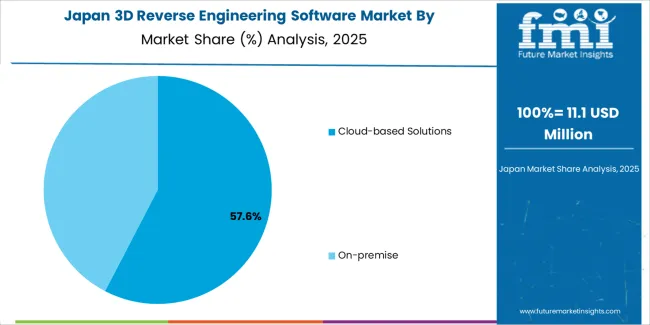
3D reverse engineering software market growth in Japan benefits from precision manufacturing demand, including advanced aerospace facilities in Tokyo and Osaka, quality integration, and manufacturing enhancement programs that increasingly incorporate reverse engineering solutions for development applications. The country maintains a 4.1% growth rate, driven by manufacturing technology advancement and increasing recognition of precision software benefits, including accurate development control and enhanced manufacturing outcomes.
Market dynamics focus on high-precision reverse engineering solutions that meet Japanese quality standards and performance effectiveness requirements important to manufacturing operators. Advanced manufacturing technology adoption creates continued demand for sophisticated software systems in aerospace facility infrastructure and manufacturing modernization projects.
Strategic Market Considerations:
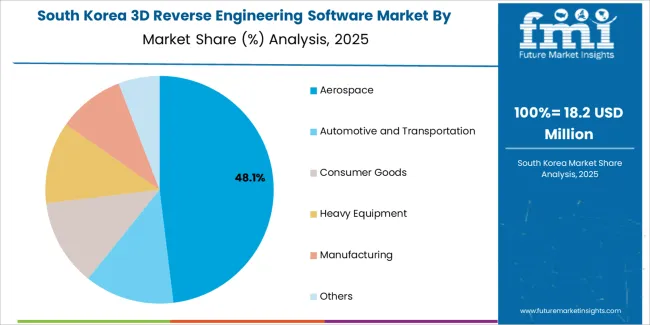
South Korea's market expansion reflects sophisticated technology adoption patterns, with major manufacturing centers in Seoul, Busan, and Incheon implementing advanced 3D reverse engineering software systems across electronics, automotive, and shipbuilding applications. The country's strategic focus on manufacturing innovation drives consistent demand for precision reverse engineering solutions, particularly in semiconductor equipment development and automotive component manufacturing. Korean manufacturers prioritize software systems that integrate seamlessly with existing digital manufacturing platforms while providing enhanced accuracy and processing capabilities for complex engineering projects.
The market benefits from strong government support for advanced manufacturing technologies and substantial private sector investment in digitization programs. Technology adoption concentrates in major industrial conglomerates that require sophisticated reverse engineering capabilities for product development and quality assurance applications, creating demand for premium software solutions with comprehensive technical support.
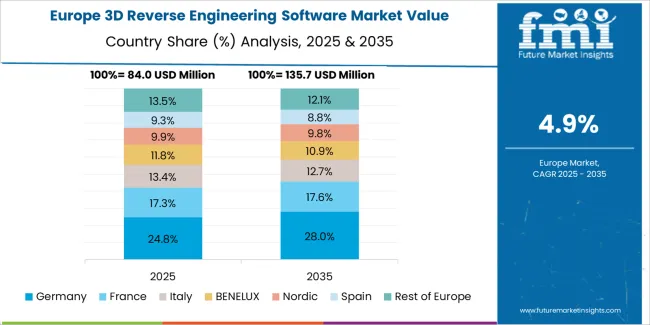
The European 3D reverse engineering software market is projected to grow from USD 76.2 million in 2025 to USD 128.5 million by 2035, registering a CAGR of 5.3% over the forecast period. Germany is expected to maintain its leadership position with a 34.7% market share in 2025, supported by its advanced manufacturing infrastructure and major aerospace centers.
United Kingdom follows with a 25.8% share in 2025, driven by comprehensive aerospace programs and precision manufacturing development initiatives. France holds a 18.9% share through specialized automotive applications and industrial compliance requirements. Italy commands a 12.1% share, while Spain accounts for 8.5% in 2025. The rest of Europe region is anticipated to gain momentum, expanding its collective share from 3.8% to 4.2% by 2035, attributed to increasing manufacturing adoption in Nordic countries and emerging engineering facilities implementing industrial modernization programs.
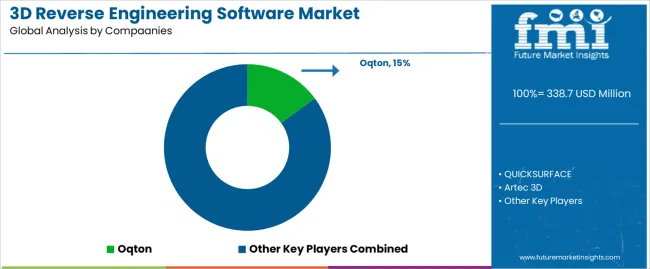
| Stakeholder | What they actually control | Typical strengths | Typical blind spots |
|---|---|---|---|
| Global brands | Distribution reach, broad software catalogs, brand recognition | Wide availability, proven quality, multi-region support | Product refresh cycles; customer dependency on brand validation |
| Technology innovators | Software R&D; advanced processing algorithms; enhanced accuracy properties | Latest technologies first; attractive ROI on performance effectiveness | Service density outside core regions; scaling complexity |
| Regional specialists | Local compliance, fast delivery, nearby customer support | "Close to customer" support; pragmatic pricing; local regulations | Technology gaps; talent retention in customer service |
| Full-service providers | Engineering programs, consulting services, training management | Lowest operational risk; comprehensive support | Service costs if overpromised; technology obsolescence |
| Niche specialists | Specialized applications, custom software, engineered solutions | Win premium applications; flexible configurations | Scalability limitations; narrow market focus |
| Item | Value |
|---|---|
| Quantitative Units (2025) | USD 338.7 million |
| Deployment Type | Cloud-based, On-premise |
| Application | Aerospace, Automotive and Transportation, Consumer Goods, Heavy Equipment, Manufacturing, Others |
| End Use | Aerospace Manufacturers, Automotive Companies, Heavy Equipment Producers, Consumer Goods Manufacturers, Engineering Consultancies |
| Regions Covered | North America, Latin America, Western Europe, Eastern Europe, East Asia, South Asia Pacific, Middle East & Africa |
| Countries Covered | China, India, Germany, Brazil, United States, United Kingdom, Japan, Canada, France, Australia, and 25+ additional countries |
| Key Companies Profiled | Oqton, QUICKSURFACE, Artec 3D, Mesh2Surface, Hexagon, Verisurf, ZEISS, Siemens, SolidWorks |
| Additional Attributes | Dollar sales by deployment type and application categories, regional adoption trends across China, India, and Germany, competitive landscape with software developers and technology providers, manufacturing operator preferences for processing effectiveness and performance optimization, integration with manufacturing platforms and project management systems, innovations in software technology and reverse engineering enhancement, and development of advanced software solutions with enhanced performance and operational optimization capabilities. |
The global 3D reverse engineering software market is estimated to be valued at USD 338.7 million in 2025.
The market size for the 3D reverse engineering software market is projected to reach USD 573.1 million by 2035.
The 3D reverse engineering software market is expected to grow at a 5.4% CAGR between 2025 and 2035.
The key product types in 3D reverse engineering software market are cloud-based solutions and on-premise.
In terms of application, aerospace segment to command 50.0% share in the 3D reverse engineering software market in 2025.






Full Research Suite comprises of:
Market outlook & trends analysis
Interviews & case studies
Strategic recommendations
Vendor profiles & capabilities analysis
5-year forecasts
8 regions and 60+ country-level data splits
Market segment data splits
12 months of continuous data updates
DELIVERED AS:
PDF EXCEL ONLINE
3D Automatic Optical Inspection Machine Market Size and Share Forecast Outlook 2025 to 2035
3D Ready Organoid Expansion Service Market Size and Share Forecast Outlook 2025 to 2035
3D Imaging Surgical Solution Market Size and Share Forecast Outlook 2025 to 2035
3D-Printed Prosthetic Implants Market Size and Share Forecast Outlook 2025 to 2035
3D Printing Ceramics Market Size and Share Forecast Outlook 2025 to 2035
3D NAND Flash Memory Market Size and Share Forecast Outlook 2025 to 2035
3D Printing Metal Market Size and Share Forecast Outlook 2025 to 2035
3D Bioprinted Organ Transplants Market Size and Share Forecast Outlook 2025 to 2035
3D Mapping and Modeling Market Size and Share Forecast Outlook 2025 to 2035
3D Audio Market Size and Share Forecast Outlook 2025 to 2035
3D Printing in Aerospace and Defense Market Analysis - Size, Share, and Forecast Outlook 2025 to 2035
3D Printed Maxillofacial Implants Market Size and Share Forecast Outlook 2025 to 2035
3D Surgical Microscope Systems Market Size and Share Forecast Outlook 2025 to 2035
3D-Printed Personalized Masks Market Size and Share Forecast Outlook 2025 to 2035
3D Printing Market Size and Share Forecast Outlook 2025 to 2035
3D Printed Packaging Market Size and Share Forecast Outlook 2025 to 2035
3D Printed Clear Dental Aligners Market Size and Share Forecast Outlook 2025 to 2035
3D IC and 2.5D IC Packaging Market Size and Share Forecast Outlook 2025 to 2035
3d-Printed Skincare Market Analysis - Size and Share Forecast Outlook 2025 to 2035
3D Display Market Size and Share Forecast Outlook 2025 to 2035

Thank you!
You will receive an email from our Business Development Manager. Please be sure to check your SPAM/JUNK folder too.
Chat With
MaRIA